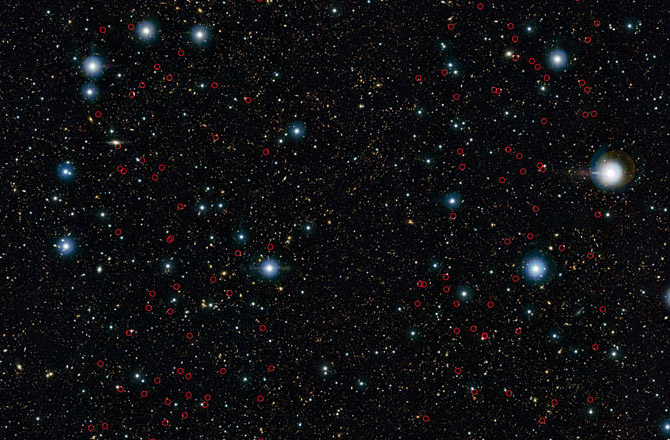
Depending on the wavelength you observe the universe in, different celestial objects and cosmic phenomena present themselves. This rule is especially true when looking deeper into the universe — the further you look, the farther back in time you can see. Because the universe is expanding, the most ancient light traveling over these vast distances becomes more difficult to observe.
This nature of space-time becomes abundantly clear when considering new discoveries in the infrared realm — light has become so red-shifted (basically stretched) that only infrared observatories can see the faint glow at the most distant corners of the cosmos.
In an effort to reveal galaxies that have remained hidden from view at these vast distances, the Visible and Infrared Survey Telescope for Astronomy (VISTA) at the ESO's Paranal Observatory in Chile has revealed some of the youngest galaxies discovered to date, galaxies that were born a mere billion years after the Big Bang. But there's something weird going on: There's lots of them. And they're monsters.
When peering that far into our universe's past, the light generated by stars that were born nearly 13 billion years ago is very difficult to resolve. Therefore, when making ancient galaxy discoveries, it's often only the brightest galaxies that get spotted. But by staring at the same patch of sky since 2009 as part of the UltraVISTA survey, and combining longer wavelength infrared data collected by NASA's Spitzer Space Telescope, astronomers have been able to tease the faint signal of hundreds of previously undetected galaxies that have, until now, been overlooked.
"We uncovered 574 new massive galaxies — the largest sample of such hidden galaxies in the early Universe ever assembled," said Karina Caputi, of the Kapteyn Astronomical Institute at the University of Groningen. "Studying them allows us to answer a simple but important question: when did the first massive galaxies appear?"
This selection of massive galaxies all seem to have formed no earlier than around 1 billion years after the Big Bang; there is little evidence from this survey that suggests massive galaxies formed before this time.
"We found no evidence of these massive galaxies earlier than around one billion years after the Big Bang, so we're confident that this is when the first massive galaxies must have formed," said coauthor Henry Joy McCracken, of the Institut d'Astrophysique de Paris.
But this finding has thrown a wrench in modern galaxy formation models — these massive galaxies shouldn't even exist; these monsters represent approximately half of the galaxies that were present between 1.1 and 1.5 billion years after the Big Bang. Models predict that only small galaxies should have existed during this epoch.
What's more, according to an ESO press release, these large galaxies contain huge quantities of dust. In fact, they have to be really dusty for the UltraVISTA survey to detect them at all. This is yet another contradiction to current galaxy formation models.
So what's going on? At the very least, there's a fundamental problem with our galactic formation theories and we need to gain a better view of these titanic galaxies so we can at least understand some of their characteristics. This discovery could ultimately revolutionize how we view the mechanisms driving stellar and galactic evolution.
Astronomers are now turning to the powerful Atacama Large Millimeter/submillimeter Array (ALMA) for answers. The observatory will try to verify VISTA and Spitzer's observations, adding another layer of detail to the mystery. Then, the ESO's 39-meter European Extremely Large Telescope (E-ELT), which is planned to go online in 2024, will be called to action.
In order to understand these monsters of the depths of the cosmos, we'll need the sheer observational power of some of the most state-of-the-art observatories on the planet. Only then can we better theorize about how these galaxies existed at the dawn of the time.
Source: European Southern Observatory



find a dozen new doors.